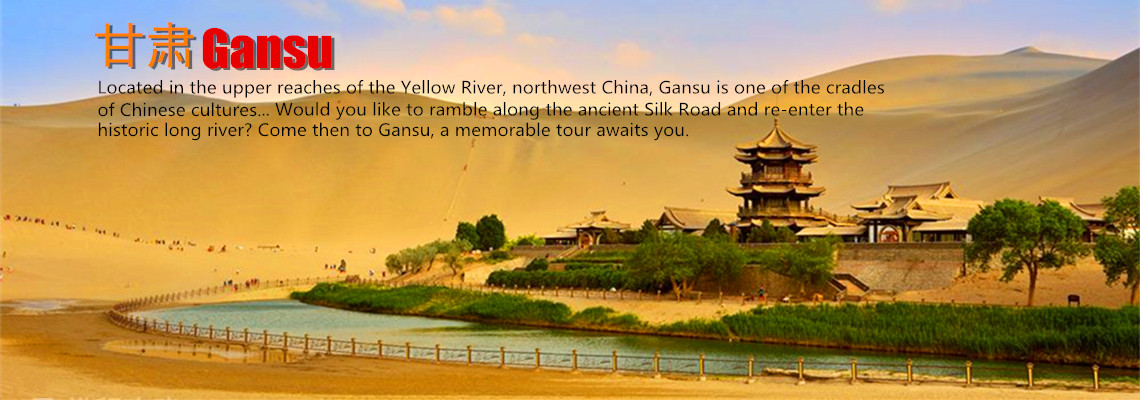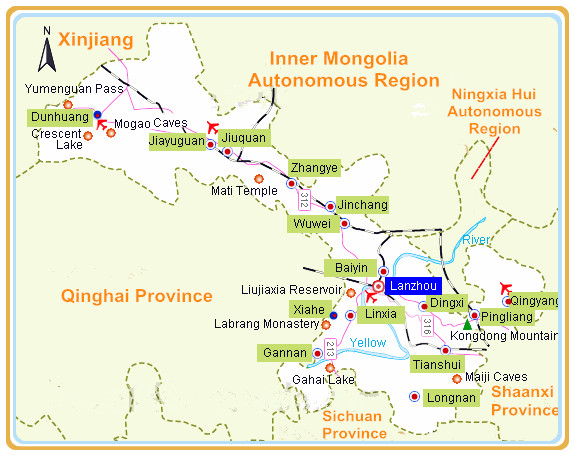Skype: neodalle-travel
Tel: +86 135 7447 2266
E-mail: sales@visitaroundchina.com

 Gansu, abbreviated as Gan or Long, was named after the initial characters of the two historical cities Ganzhou (today’s Zhangye City) and Suzhou (today’s Jiuquan City). As most part of the province is lying in the west of Longshan Mountain (Liupan Mountain), and it was set as an administrative region of Longyoudao (Longyou, literally the right side of Mountain Long) in the Tang Dynasty, Gansu Province is also called“Long”.
Gansu, abbreviated as Gan or Long, was named after the initial characters of the two historical cities Ganzhou (today’s Zhangye City) and Suzhou (today’s Jiuquan City). As most part of the province is lying in the west of Longshan Mountain (Liupan Mountain), and it was set as an administrative region of Longyoudao (Longyou, literally the right side of Mountain Long) in the Tang Dynasty, Gansu Province is also called“Long”.
Located in Northwest China with diverse climates and landforms, Gansu Province is wedged between the Qinghai-Tibetan Plateau, the Loess Plateau and the Inner Mongolian Plateau. And it crosses three river basins including the Yellow River, Yangtze River and inland rivers. Gansu Province has a population of over 26 million people and covers an area of 454,400 square kilometers, extending 1,655 kilometers from east to west. The capital city, Lanzhou, is geographically located in the center of China.
Gansu Province enjoys rich culture heritage. Diverse cultures add radiance and beauty to each other here—Silk Road Culture, Yellow River Culture, the Great Wall Culture, and Ancestral Culture. Both the symbol of China Tourism—the Bronze Galloping Horse Treading on a Flying Swallow, and the symbol of the earliest postal service of China—the Painting of Postal Messenger were unearthed in Gansu. Now, there are 2 World Cultural Heritages, 8 Excellent Tourism Cities, 18 National Intangible Cultural Heritages, 8 National Historical and Cultural Cities and Towns,as well as 72 Major Historical and Cultural Sites Protected at the National Level in Gansu.
Beautiful scenery can be found in Gansu including gobi desert, glaciers, snow mountains, Danxia landform, canyons and Karst caves. In Gansu, there are 1 World Biosphere Reserve, 3 National 5As Tourist Attractions, 3 National Parks, 23 National Forest Parks, 4 National Geological Parks, 9 National Water Parks and 16 National Nature Reserves.
Gansu has been a multi-ethnic province since ancient times, and now all 56 ethnic groups of China can be found here. There are 16 ethnic minorities having a population of more than 1,000 people, including Han, Tibetan, Hui, Yugur, Tu and Mongolian, etc.. Three unique ethnic minorities, Dongxiang, Yugur and Bao’an, only live in Gansu, enjoying their rich and special folk customs.
Gansu province is famous for its rich and varied resources for tourism development -- with all kinds of topography resources except oceans and reefs. Gansu is known as the birthplace of Chinese civilization, the museum of natural wonders, the garden of folk customs as well as the favorable destination of leisure tourism.
Gansu province is a scenery passage in the Silk Road where you can learn about the history, taste the culture, travel the mountains and rivers as well as experience the special folk customs. Welcome to Gansu!
Gansu province is also called Long or Gan for short. It is the cradle of Chinese culture. According to archeological findings, the Yangshao Culture emerged in this area about 6,000 years ago. During the reign of Emperor Wu of the Western Han Dynasty (206BC-AD8), the Silk Road linking the Central Plains with the Western Regions was built.
This ancient trade route starts in the old capitals of Luoyang and Xi'an, reaches the Yellow River at Lanzhou, follows along the Hexi Corridor and stretches along the edge of deserts and mountains. Before the discovery of the sea route to India, the Silk Road was the most important connection between the Orient and the West, via which China's ancient four inventions, pottery, iron wares were exported to the West, and astronomy, mathematics, religions and gems were introduced into China. Gansu was officially established during the Yuan Dynasty (1271-1368).
So far as the industries are concerned, there are equipment manufacture for petroleum, chemical industry, non-ferrous metals and petrochemical industry, all of which have occupied the important position in the whole country. The agricultural products mainly include wheat, cotton, flax and sugar beet, among which flax occupies an important position in the country.
The traditional specialties of fame are carved jade wine cup, carpets modeled after ancient ones, three-red apples, angelica, almond, benne, Bailan melon and lily, etc. Some of the rare animals found in Gansu include giant panda, golden monkey, red deer, snow rooster and wild donkey.
Rich cultural relics are the most important tourist resources in Gansu province. The famous Silk Road is the link in ancient time between China and western countries. Oases, ancient towns, passes, part of the Great Wall, temples and grottos attract thousands of visitors home and abroad every year. Places of historic and cultural interest include the Dunhang Grottos and the Jiayu Pass (an important outpost in ancient China and at the western end of the Great Wall), etc.
Gansu is renowned as home of grotto art. The Dunhuang Mogao Grottos, also known as the "Thousand Buddha Grottoes", is located at the rock side of the Singing Sand Mountain in Dunhuang city of Gansu province. It is the largest and best-preserved Buddhist art museum and also a post along the ancient Silk Road. According to historical records, the Mogao Grottos were carved in 366. There are 492 grottos in existence with some 45,000 square meters of murals, and 415 painted clay figures. It's worthy of the name of Art Treasure House of China.
 Ask Questions ?
Ask Questions ?